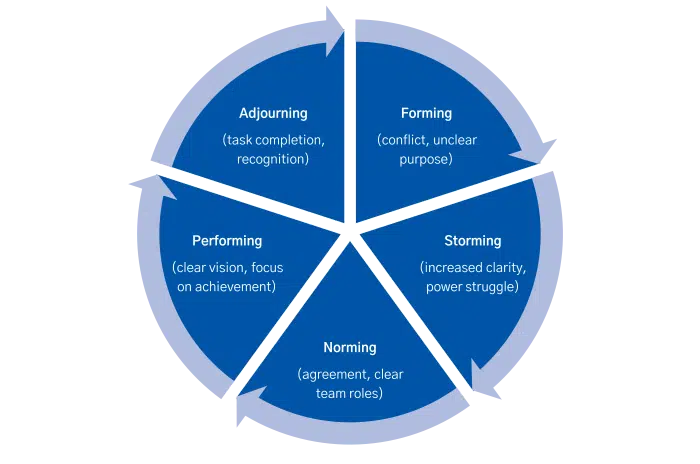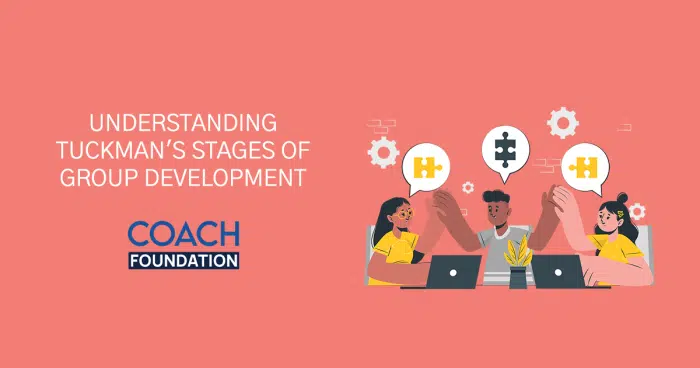Blog » Coaching Models and Techniques » Jung’s Theory of Personality
Jung’s Theory of Personality
The team members must be able to cooperate in order to jointly contribute to team outcomes for teams to be effective. Yet, this is not a natural process; rather, it grows as the team collaborates. You have probably experienced being assigned to a team to complete a task or project for school.

When your team first meets, you probably sit around and stare at each other, unsure of where to start. You start out as individuals who have been given the task of working together rather than a team. As you become more familiar with one another, you learn what to anticipate from one another, how to divide labor and assign duties, and how to coordinate your work.Through this process, you begin to operate as a team instead of a collection of individuals.
In Brief : Breaking Down Tuckman’s Stages Of Group Development
- Forming – In this stage, group members are dependent, seeking safety, and gathering information; no direct cost mentioned.
- Storming – Conflict arises as group members compete and organize, addressing issues like authority and leadership; no direct cost mentioned.
- Norming – Group cohesion and interpersonal relationships characterize this stage, with increased trust and openness; no direct cost mentioned.
- Performing – Groups at this stage demonstrate full interdependence, flexibility, and a focus on both tasks and people; no direct cost mentioned.
- Adjourning – The final stage involves ceasing task behaviors, disengaging from interpersonal contacts, and acknowledging group achievements; no direct cost mentioned.
The Fundamentals
According to research, teams go through distinct phases of development. An educational psychologist named Bruce Tuckman discovered a five-stage development process that most teams adhere to in order to achieve high performance. Forming, storming, norming, performing, and adjourning were the stages he identified and studied.
History
The well-known steps of forming, storming, norming, performing, and adjourning are presented in the model, which was developed by Bruce W. Tuckman in 1965 and revised by Tuckman and Mary Ann Conover Jensen in 1977. This paradigm has a distinctive history because it was first widely used by HRD practitioners before later appearing frequently in academic literature. It was significant because it addressed the absence of relevant research as well as the growing role of groups in the workplace.
Breaking Down Tuckman’s Stages of Group Development
Tuckman’s Team Building Model | How to build a Team?
Bruce Tuckman first developed the forming-storming-norming-performing model of group development in 1965. He said that these phases are all essential and inevitable for a team to develop, meet difficulties, address issues, come up with answers, plan work, and produce results.
Tuckman postulated that in addition to these factors, interpersonal relationships and task activity would enhance the four-stage model, which is necessary to successfully navigate and create an effective group function.
Tuckman was aware that these inevitable phases were crucial to team growth and development.

Forming
Dependence is a hallmark of interpersonal relationships during the Forming stage. Members of the group rely on safe, predictable behavior and look to the leader for direction.
Members of the group want to be accepted by the group and require assurance that the group is safe. They started gathering information and impressions regarding their shared characteristics and distinctions, as well as developing preferences for potential subgrouping.
The goal of social norms appears to be to maintain simplicity and to steer clear of conflict. Important subjects and emotions are not discussed.
Orientation is another one of the key job tasks. Members make an effort to become familiar with one another as well as the jobs.
Determining the task’s scope, how to approach it, and similar issues are the main topics of discussion. To grow from this stage to the next, each member must relinquish the comfort of non-threatening topics and risk the possibility of conflict.
Storming
Competition and conflict in the personal-relations dimension and organization in the task-functions dimension are characteristics of the following stage, which Tuckman refers to as storming.
Conflict in the group’s interpersonal relationships unavoidably arises as members strive to organize for the task.
People must adjust their thoughts, feelings, attitudes, and beliefs to fit the way the group operates. Because of “fear of exposure” or “fear of failure,” there will be an increased desire for structural explanation and commitment.
Conflicts do exist, whether or not they manifest as challenges for the organization. There will be concerns about who will be in charge of what, the rules, the compensation structure, and the evaluation standards.
Conflicts over authority, structure, power, and leadership are reflected in these. Based on new competitiveness and hostility issues, members’ behavior may undergo significant swings.
Some participants may choose to remain absolutely mute during this period due to the discomfort it causes while others make an effort to dominate.
Group members must switch from a “testing and proving” approach to a problem-solving mentality in order to advance to the next step.
The ability to listen appears to be the most crucial quality for assisting groups in progressing to the following step.
Norming
Cohesion characterizes interpersonal relationships during Tuckman’s Norming stage. Members of the group actively acknowledge each other’s contributions, work to maintain the group as a whole, and resolve conflicts among themselves.
Members aggressively challenge one another and are open to revise their previous notions or attitudes in response to information provided by other members. Cliques disintegrate as leadership is shared.
The degree of trust in members’ personal relationships increases as they get to know and understand one another, which aids in the formation of group cohesion.
As interpersonal problems are resolved, people start to feel a sense of belonging to the group throughout this stage of development (if the group makes it that far).
The primary task function of stage three is the exchange of information among group members, who explore task-related actions while exchanging feelings and ideas. Ingenuity is abundant.
The group members’ interactions are defined by openness and sharing of information on both a personal and task level if they reach this stage of information flow and cohesiveness. They enjoy being a member of a productive team.
The main disadvantage of the norming stage is that individuals may start to worry about the group’s impending dissolution and may become resistant to any kind of reform.
Performing
Not all ensembles make it to the Performance stage. Members of the group can grow their ability, scope, and depth of interpersonal relationships to full interdependence if they can go to stage four. People can operate as well on their own, in smaller groups, or as a whole at this time.
Their responsibilities and powers change in response to the group’s and an individual’s shifting requirements.
Interdependence in interpersonal interactions and problem-solving in the context of task functions characterize stage four. The group ought to be working really hard by this point.
Members are now self-assured, and they no longer require collective approval. Members have a strong focus on both tasks and people. There is harmony: full group identity, excellent group morale, and group loyalty is at an all time high.
Adjourning
The last stage in Tuckman’s model, adjourning, is ceasing task behaviors and disengaging from interpersonal contacts.
A planned conclusion usually includes opportunities for participants to say their goodbyes individually as well as acknowledgment for participation and accomplishment.
A group’s conclusion may cause some anxiety, or perhaps a brief crisis. The group’s dissolution represents a regression from renouncing control to renouncing membership in the group.
The interventions that facilitate task termination and the disengagement process are the most successful at this stage.
Conclusion
Tuckman’s Theory provides a clear picture of what most teams experience.
It can be useful to have a concept of what to anticipate when assembling a team to work on a project.
You can better educate your clients about what to expect while working in a group dynamic by studying this theory and learning to recognise the stages in real life.
Frequently Asked Questions (FAQs)
How can coaches use Tuckman’s Model for conducting Group Sessions?
This model is frequently used by coaches as a tool for evaluating both the team’s level of cohesion and the maturity of the relationships among its members.
This model, in my opinion, serves as a roadmap for team development as well as an assessment tool.
We can align our actions so that we can lead the team towards those results as quickly as possible by understanding the focus of the team during each stage and being aware of what kinds of outcomes allow the team to progress to the next stage.
What are the benefits of using Tuckman’s theory?
There are many outlined benefits of Tuckman’s theory. The main ones are:
1. The versatility of usage
2. The clear, dedicated distinction between the five stages
3. Ease to set deadlines for incremental improvement through the stages
4. The ability to lead the group towards higher performance and efficiency
5. Ease of predictability of group behavior
6. Ease of tracking the changes in intra-group behaviors
What are the three educational implications of the Tuckman model?
The three educational implications of Tuckman’s model are as follows:
1. The duration and intensity of the five phases can vary between various groups.
2. It is possible for a team to revert to the previous stage of development.
3. A team may never complete its journey through the five stages of development
What are the disadvantages of Tuckman theory?
Tuckman’s theory has five key phases that are very challenging to maintain one after the other. To keep up excellent relationships and effective communication within the organization, members must adhere to many rules.
Although it offered some suggestions to lessen disagreements, there isn’t an immediate fix for every issue in group communication.
Tuckman’s model also left out the possibility that the storming stage might have continued. The Tuckman model has failed to explain how and why a group changes over time, to sum up.
Is the Tuckman model still relevant?
Dr. Tuckman’s model has stood the test of time because it remains highly relevant and beneficial. Since his related work was published, it has been supported by additional peer-reviewed research.
It has received recommendations and coverage from leading organizations including Google, Harvard Business Review, IEEE, Forbes, MIT, Fast Company, NASA, Microsoft, TNW, Project Management Institute, Scrum Alliance, Scrum.org, Association for Project Management, Gartner, and many others.

